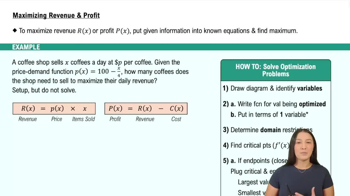Table of contents
- 0. Functions7h 52m
- Introduction to Functions16m
- Piecewise Functions10m
- Properties of Functions9m
- Common Functions1h 8m
- Transformations5m
- Combining Functions27m
- Exponent rules32m
- Exponential Functions28m
- Logarithmic Functions24m
- Properties of Logarithms34m
- Exponential & Logarithmic Equations35m
- Introduction to Trigonometric Functions38m
- Graphs of Trigonometric Functions44m
- Trigonometric Identities47m
- Inverse Trigonometric Functions48m
- 1. Limits and Continuity2h 2m
- 2. Intro to Derivatives1h 33m
- 3. Techniques of Differentiation3h 18m
- 4. Applications of Derivatives2h 38m
- 5. Graphical Applications of Derivatives6h 2m
- 6. Derivatives of Inverse, Exponential, & Logarithmic Functions2h 37m
- 7. Antiderivatives & Indefinite Integrals1h 26m
- 8. Definite Integrals4h 44m
- 9. Graphical Applications of Integrals2h 27m
- 10. Physics Applications of Integrals 2h 22m
5. Graphical Applications of Derivatives
Applied Optimization
Problem 4.5.18
Textbook Question
Rectangles beneath a parabola A rectangle is constructed with its base on the x-axis and two of its vertices on the parabola y = 48 - x². What are the dimensions of the rectangle with the maximum area? What is the area?
 Verified step by step guidance
Verified step by step guidance1
Identify the function for the area of the rectangle. The base of the rectangle is on the x-axis, and its vertices are on the parabola y = 48 - x². If the x-coordinates of the vertices are -a and a, then the width of the rectangle is 2a, and the height is y = 48 - a².
Express the area A of the rectangle as a function of a: A(a) = width * height = 2a * (48 - a²).
Simplify the area function: A(a) = 2a * (48 - a²) = 96a - 2a³.
To find the maximum area, take the derivative of A with respect to a: A'(a) = d/da (96a - 2a³).
Set the derivative A'(a) equal to zero to find the critical points: Solve A'(a) = 0 for a. Then, use the second derivative test or analyze the sign changes of A'(a) to determine if the critical point is a maximum.
 Verified video answer for a similar problem:
Verified video answer for a similar problem:This video solution was recommended by our tutors as helpful for the problem above
Video duration:
9mPlay a video:
Was this helpful?
Key Concepts
Here are the essential concepts you must grasp in order to answer the question correctly.
Parabola
A parabola is a symmetric curve defined by a quadratic function, typically in the form y = ax² + bx + c. In this case, the parabola is given by y = 48 - x², which opens downwards. Understanding the properties of parabolas, such as their vertex and axis of symmetry, is crucial for determining the maximum area of the rectangle inscribed beneath it.
Recommended video:

Properties of Parabolas
Optimization
Optimization in calculus involves finding the maximum or minimum values of a function. To solve the problem, we need to express the area of the rectangle as a function of its dimensions and then use techniques such as taking derivatives to find critical points. The maximum area corresponds to the highest value of this area function within the defined constraints.
Recommended video:

Intro to Applied Optimization: Maximizing Area
Area of a Rectangle
The area of a rectangle is calculated by multiplying its width by its height. In this scenario, the width is determined by the x-coordinates of the rectangle's vertices on the x-axis, while the height is given by the y-coordinate of the parabola at those x-values. Understanding how to express the area in terms of these variables is essential for solving the problem.
Recommended video:

Estimating the Area Under a Curve Using Left Endpoints

 1:13m
1:13mWatch next
Master Intro to Applied Optimization: Maximizing Area with a bite sized video explanation from Callie
Start learningRelated Videos
Related Practice








